The AMD Ryzen 3 3300X and 3100 CPU Review: A Budget Gaming Bonanza
by Dr. Ian Cutress on May 7, 2020 9:00 AM EST*We are currently in the middle of revisiting our CPU gaming benchmarks, but the new suite was not ready in time for this review. We plan to add in some new games (Borderland 3, Gears Tactics) and also upgrade our gaming GPU to a RTX 2080 Ti.
Gaming: Ashes Classic (DX12)
Seen as the holy child of DirectX12, Ashes of the Singularity (AoTS, or just Ashes) has been the first title to actively go explore as many of the DirectX12 features as it possibly can. Stardock, the developer behind the Nitrous engine which powers the game, has ensured that the real-time strategy title takes advantage of multiple cores and multiple graphics cards, in as many configurations as possible.
As a real-time strategy title, Ashes is all about responsiveness during both wide open shots but also concentrated battles. With DirectX12 at the helm, the ability to implement more draw calls per second allows the engine to work with substantial unit depth and effects that other RTS titles had to rely on combined draw calls to achieve, making some combined unit structures ultimately very rigid.
Stardock clearly understand the importance of an in-game benchmark, ensuring that such a tool was available and capable from day one, especially with all the additional DX12 features used and being able to characterize how they affected the title for the developer was important. The in-game benchmark performs a four minute fixed seed battle environment with a variety of shots, and outputs a vast amount of data to analyze.
For our benchmark, we run Ashes Classic: an older version of the game before the Escalation update. The reason for this is that this is easier to automate, without a splash screen, but still has a strong visual fidelity to test.
Ashes has dropdown options for MSAA, Light Quality, Object Quality, Shading Samples, Shadow Quality, Textures, and separate options for the terrain. There are several presents, from Very Low to Extreme: we run our benchmarks at the above settings, and take the frame-time output for our average and percentile numbers.
All of our benchmark results can also be found in our benchmark engine, Bench.
| AnandTech | IGP | Low | Medium | High |
| Average FPS | 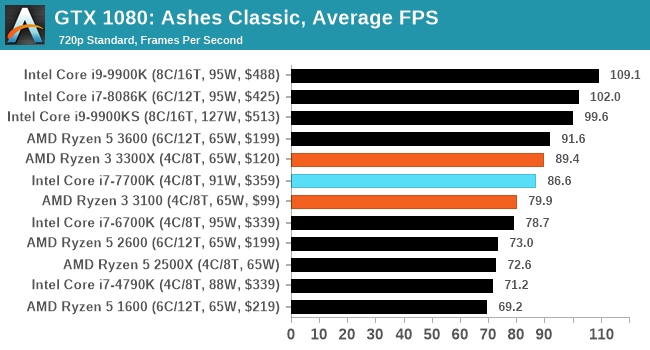 |
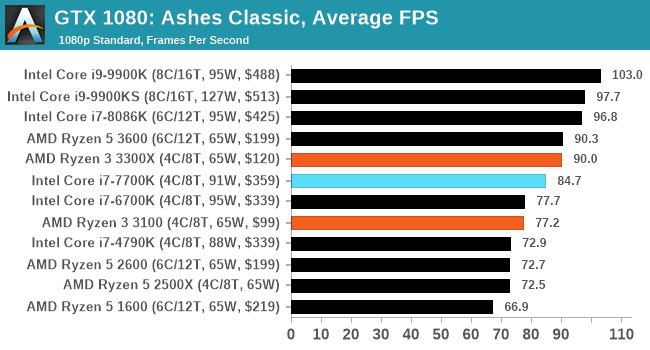 |
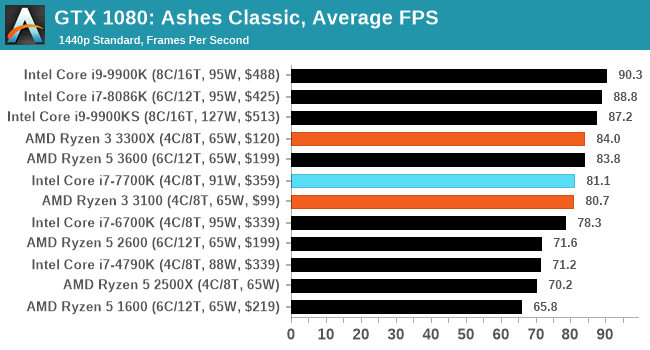 |
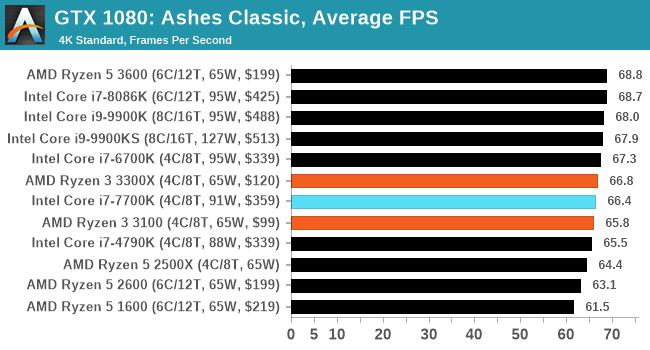 |
| 95th Percentile |  |
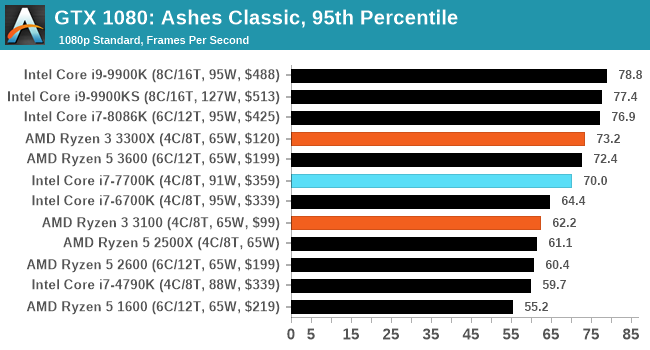 |
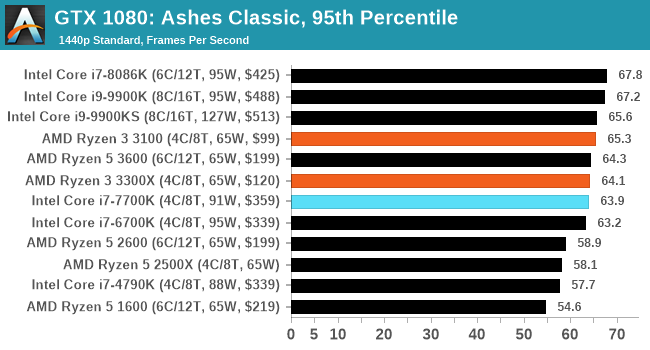 |
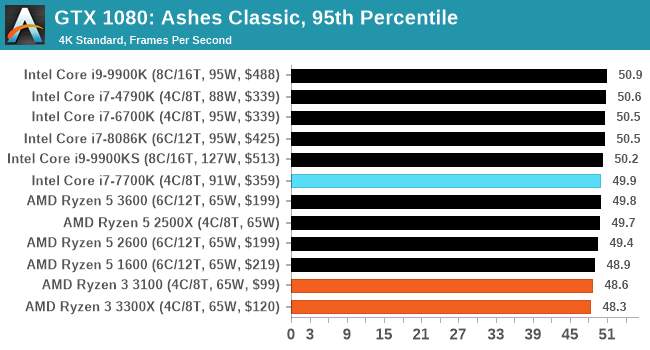 |


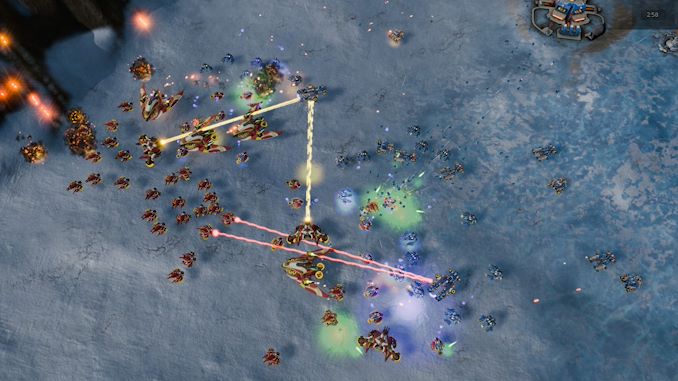









249 Comments
View All Comments
PeterCollier - Monday, May 11, 2020 - link
Did you really feel the need to add 40 comments a week later the article was published? And on a Monday? Please tell us what company, Intel or AMD, that you work for.Spunjji - Tuesday, May 12, 2020 - link
Yes, reading article comments five days "late" definitely indicates that I work for a tech company, and not that I only visit this place once or twice a week during my lunch break. But hey, basing trolls is what I do for amusement. What's your excuse for trolling in the first place?kepstin - Friday, May 8, 2020 - link
I suspect that the 2600 was put into the charts as a stand-in for the 1600AF. The 1600AF should perform very close to the 2600 in most benchmarks - just a touch slower due to reduced clock speeds.rabidpeach - Friday, May 8, 2020 - link
1600af is represented by the 2600. the 2600 is just slightly better than it. this is not a problem. also amazon is out of them. the only benchmarks these processors win are high core count. daily life the 100 3100 will be faster so why hobble yourself with the smaller cache and 12nm?DanNeely - Thursday, May 7, 2020 - link
Something I've been wondering about for a while, is that when the first Ryzen announcements were made I read articles saying that the inclusion of some SATA/USB on the CPU itself would allow for cheaper entry level mobos/systems that used the CPU as an SoC without a chipset at all. However I don't recall ever seeing anything built that way. I'm inclined to doubt that it is possible but that no one has ever done it because for a low end system without a discrete GPU the CPU appears to have enough IO to cover all the bases. Were the initial reports wrong? Is it something that's only shown up in cheap OEM systems but never DIY boards?neblogai - Thursday, May 7, 2020 - link
Deskmini A300 is made this way- althouth it has no dGPU slot and requires an APU. This also allows the PC to idle at just 8-10W, compared to ~20W(?) for PCs that use motherboards with chipsets.DanNeely - Friday, May 8, 2020 - link
just one system by a single vendor. Kinda disappointing IMO since the CPU has enough connectivity for a basic no frills system, and would've been a reasonable option for a budget mITX board.Spunjji - Monday, May 11, 2020 - link
Agreed. I'd love to build a system in my existing USFF ITX case using something like an ITX version of the Deskmini A300 board, but for some reason nobody's doing it. I'm genuinely cluesless as to what "some reason" might be, too, as the A300 proves the concept just fine.Slash3 - Thursday, May 7, 2020 - link
ASRock's DeskMini A300 series systems are the closest configuration to this, lacking a secondary chipset.notb - Thursday, May 7, 2020 - link
A lot of focus in this text is about how 3300X ($120) compares to 7700K ($329, 3 years ago).Wouldn't it be nice to see how 3300X compares to high-end original Ryzen? ;)
The choice of CPUs is really weird. 8086K? 4790K? Really?
1600X, 1700, 1700X, 1800X - all probably beaten in most games and synthetic single-thread. In a lot of software as well (since 7700K used to beat 1800X occasionally).
1800X: $499